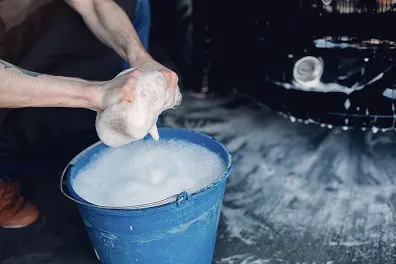If you’ve ever noticed a strange smell, cloudy water, or a slimy layer inside your overhead tank, it’s a clear sign your cold water tank needs cleaning. The truth is — cold water tank cleaning is not just about hygiene; it’s about protecting your family’s health.
According to a 2024 WHO report, stored household water can harbor bacteria like E. coli if tanks aren’t cleaned at least once every 3 months. That’s why every home, especially those relying on cold water storage systems, should follow a regular, chemical-free cleaning routine.
In this guide, you’ll learn how to clean your cold water tank step by step using eco-friendly methods, avoid costly mistakes, and keep your home’s water supply fresh and safe — without harsh chemicals.
Why Cold Water Tank Cleaning Is So Important
Cold water tanks often sit quietly in lofts or rooftops — unseen, untouched, and forgotten. But over time, dust, algae, rust, and sediment settle at the bottom. If not cleaned regularly, these impurities contaminate your water and even damage your plumbing system.
In small or medium homes, stored cold water is used for cooking, brushing, washing, and sometimes even drinking. So, if the tank is dirty, every part of your daily routine is at risk.
Regular domestic water tank care prevents bacteria growth, removes algae buildup, and keeps the water free from bad odor and discoloration. It also ensures your tank lasts longer and your water pressure stays consistent.
How Often Should You Clean a Cold Water Tank?
Experts recommend cleaning your cold water tank every 3 to 6 months, depending on usage and water quality in your area.
- If you notice rust, sediment, or algae, clean immediately.
- In dusty or humid climates, clean more often.
- For newly installed tanks, the first cleaning should be done within 90 days.
Regular water tank maintenance ensures not just cleanliness but also prevents long-term damage to internal fittings and outlets.
Signs Your Cold Water Tank Needs Immediate Cleaning
Watch for these common warning signs:
- Cloudy, murky, or brown water
- Metallic or musty odor
- Reduced water pressure
- Algae or green slime around tank walls
- Insects or debris floating on the surface
If you spot any of these, it’s time to act fast with a proper cold water tank cleaning routine.
Tools and Supplies You’ll Need
You don’t need expensive tools — just basic household items:
- A soft-bristle brush or long mop
- White vinegar or baking soda
- A bucket and clean cloths
- Rubber gloves
- Clean water supply
- Flashlight (for checking corners)
Tip: Avoid using bleach or detergents. They leave harmful residues and can alter the taste and safety of stored water.
Step-by-Step: How to Clean a Cold Water Tank
- Turn Off the Supply & Drain the Tank
Shut off the main valve connected to the tank. Open the outlet valve to drain all water. Use the remaining water for cleaning your floors or garden — no waste! - Remove Debris and Sediment
Use a bucket or scoop to take out debris from the bottom. - Scrub the Tank Walls
With a soft brush or mop, gently scrub the inner walls and base. Mix baking soda and water into a paste — it’s perfect for removing algae and stains. - Rinse Thoroughly
Rinse two to three times with clean water to remove all dirt and residue. - Disinfect Naturally
Mix 1 part white vinegar with 3 parts warm water. Fill the tank about one-third and let it sit for 30 minutes. Vinegar kills bacteria and neutralizes odor — no chemicals needed. - Drain, Wipe & Air-Dry
Drain again and wipe with a clean cloth. Leave the tank open for 30–40 minutes to dry completely before refilling. - Seal and Inspect
Close the lid tightly to prevent dust or insects from entering. Check for leaks or cracks.
Eco-Friendly Cleaning Alternatives
If you want a completely non-toxic tank cleaning routine, here are a few natural disinfectants:
- Baking Soda: Removes stains and odors.
- Vinegar: Mild germ killer.
- Lemon Juice: Natural deodorizer and antibacterial.
These are safe, biodegradable, and ideal for household water hygiene — especially if your water is used for cooking or washing vegetables.
Real-Life Case Study: Cold Water Tank Cleaning in Seattle, USA
A family in Seattle noticed their bathroom water turning slightly brown with a metallic odor. Their 500-gallon cold water storage tank hadn’t been cleaned for a year. Instead of using bleach, they decided to go chemical-free.
They drained the tank, scrubbed it using a mix of baking soda and vinegar, and rinsed it thoroughly. Within hours, the odor disappeared. After repeating the cleaning every 4 months, their water flow improved by 25%, and their plumber confirmed zero rust buildup.
This simple shift to natural cleaning saved them $300 annually in maintenance costs and gave them fresh, safe water year-round.
Common Mistakes to Avoid
- Using bleach or harsh detergents — they corrode the plastic and leave residue.
- Forgetting to rinse after cleaning.
- Leaving the lid open after washing (dust and bugs can re-enter).
- Ignoring outlet pipes — buildup there can recontaminate your tank.
Maintenance Tips for Long-Term Clean Water
- Keep the tank covered tightly at all times.
- Clean inlet filters every 6 months.
- Avoid placing tanks under direct sunlight.
- Flush out unused water every few weeks.
- Install a sediment pre-filter if your area has hard water.
Health Benefits of Regular Cold Water Tank Cleaning
- Prevents bacteria and algae growth.
- Reduces the risk of waterborne diseases like cholera or diarrhea.
- Keeps water odor-free and crystal clear.
- Extends the life of your overhead or underground water tank.
Remember: clean water = healthy family.
Related Articles:
- Internal: Hot Water Tank Cleaner – Learn how to maintain your home’s hot water tank efficiently.
Conclusion
Keeping your cold water tank clean isn’t just about appearance — it’s about protecting your health, plumbing system, and overall home hygiene. Regular cold water tank cleaning prevents bacterial growth, rust buildup, and unpleasant odors.
By using simple, natural ingredients like vinegar, baking soda, and lemon juice, you can clean your tank safely without harsh chemicals. This approach not only saves money but also protects your family’s health and the environment.
So, make it a habit — clean your tank every few months, inspect for leaks, and keep the lid tightly sealed. A few hours of care today will give you clean, safe, and fresh water every single day.
Frequently Asked Questions (FAQs)
1. How often should I clean my cold water tank?
Every 3–6 months. If you notice odor, discoloration, or algae, clean immediately.
2. Can I use vinegar for disinfecting the tank?
Yes, vinegar is a natural disinfectant that removes bacteria and odor safely.
3. Is cold water tank cleaning different from hot water tank cleaning?
Yes. Cold water tanks are more prone to algae, while hot water tanks often build up scale. You can read our detailed guide here: Hot Water Tank Cleaner.
4. Why is my water brown after cleaning?
That’s usually leftover sediment. Flush the tank again and rinse all outlet pipes.
5. How do I keep my tank clean for longer?
Keep it sealed, use natural disinfectants, and clean filters regularly.
References
- External: EPA – Safe Drinking Water Guide – U.S. standards for household water safety.
Summary
Regular cold water tank cleaning keeps your home’s water fresh, safe, and free from bacteria. Using simple natural ingredients like vinegar and baking soda is enough to disinfect without harsh chemicals.
Clean your tank every few months to prevent algae, odors, and rust — ensuring healthy, clean water for your family all year round.
Ethan Wells is the author of Water Tank Guides, a blog focused on practical tips for water tank cleaning, maintenance, and installation. His mission is to help readers keep their water clean, safe, and their tanks long-lasting through simple, easy-to-follow guides.

